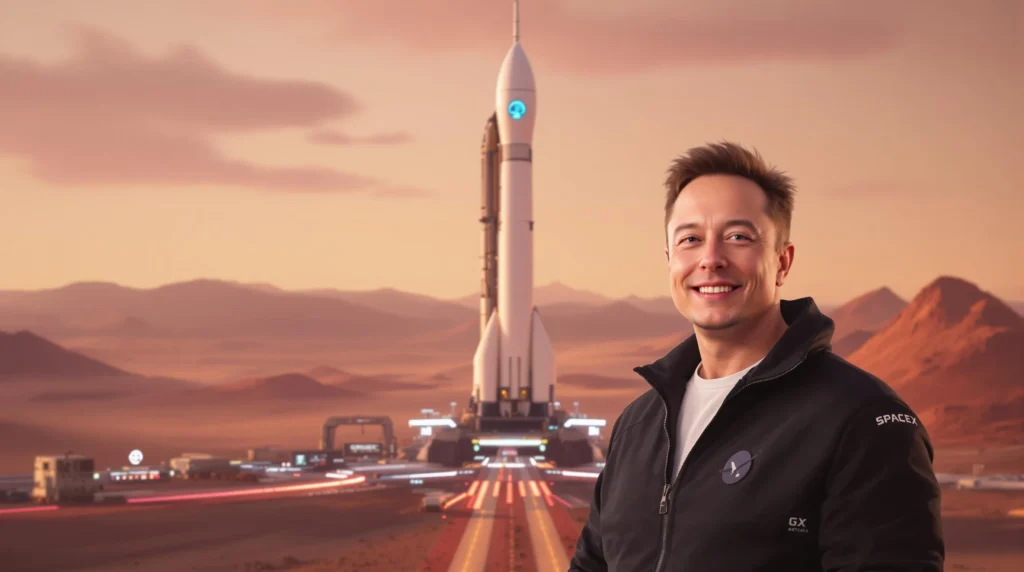Visionary Musk’s Bold Mars Plan: Robots & AI to Conquer Red Planet

Hold onto your helmets, space enthusiasts and tech aficionados! Elon Musk, the ever-innovative mind behind SpaceX and Tesla, has just dropped another interstellar bombshell. Imagine this: the next SpaceX Mars rocket soaring through the cosmos, not just with astronauts, but potentially carrying a crew of Optimus robots powered by the cutting-edge Grok AI. Yes, you read that right. Musk himself hinted at this incredible possibility, suggesting a late 2026 launch. Let’s dive into what this audacious plan could mean for the future of space exploration and artificial intelligence.
Why Send Optimus Robots and Grok AI to Mars?
So, why exactly would Musk want to ship his humanoid robots and advanced AI to the Red Planet? It’s not just about a cool tech demo. This move could be a game-changer for establishing a sustainable human presence on Mars. Think about it – Mars is a harsh and unforgiving environment. Sending humans first for every task is risky and resource-intensive. Optimus robots, designed to handle a wide range of tasks, could be the perfect pioneers.
Here’s a breakdown of the potential benefits:
- Pioneering Infrastructure Development: Before human boots even touch Martian soil for extended stays, Optimus robots could be deployed to construct habitats, research facilities, and essential infrastructure. They can handle the heavy lifting, literally, in environments unsafe or unsuitable for humans.
- Resource Extraction and Preparation: Mars has resources, but accessing them is no walk in the park. Robots can be programmed to mine resources like water ice, process Martian regolith, and prepare the ground for agriculture – all crucial steps for long-term Martian settlements.
- Scientific Exploration and Research: Equipped with sensors and tools, Optimus robots can conduct continuous scientific research, gather data, and explore areas inaccessible or too dangerous for human explorers initially. This expands our understanding of Mars exponentially.
- Risk Mitigation for Human Missions: By deploying robots beforehand, we significantly reduce the risks associated with initial human missions. Robots can identify hazards, test systems, and ensure a safer environment for astronauts upon arrival.
Grok AI: The Brains Behind the Martian Operation
Now, let’s talk about Grok AI. It’s not just about sending robots; it’s about sending intelligent, adaptable robots. Grok AI, developed by Musk’s xAI company, is designed to be conversational, curious, and even a bit rebellious in its learning approach. Imagine an AI that can:
- Problem-Solve Autonomously: Mars will throw curveballs. Grok AI can enable Optimus robots to analyze situations, make decisions, and solve problems independently, even with communication delays from Earth.
- Learn and Adapt to Martian Conditions: The Martian environment is vastly different from Earth. Grok AI can help robots learn from their experiences, adapt to changing conditions, and optimize their performance in real-time.
- Communicate and Collaborate: Grok AI could facilitate communication between robots, and potentially even with future human crews, making operations more efficient and coordinated.
- Process and Interpret Martian Data: The sheer volume of data from Mars will be immense. Grok AI can analyze this data, identify patterns, and provide valuable insights to scientists back on Earth.
SpaceX’s Mars Rocket: Starship to the Rescue?
Of course, all of this hinges on SpaceX’s Mars rocket program, specifically Starship. Starship is SpaceX’s fully reusable spacecraft designed for deep space missions, including Mars colonization. Its massive cargo capacity and reusability are essential for transporting large payloads like robots, habitats, and supplies to Mars.
Key features of Starship that make this Martian robot mission feasible include:
| Feature | Significance for Mars Mission |
|---|---|
| Large Payload Capacity | Can carry Optimus robots, Grok AI systems, and necessary support equipment in a single launch. |
| Reusable Design | Reduces the cost of space travel significantly, making ambitious missions like this more economically viable. |
| In-space Refueling Capability (Planned) | Potentially allows for longer and more complex missions to Mars and beyond. |
| Rapid Iteration and Development | SpaceX’s agile development approach allows for quick improvements and adaptations to Starship, increasing mission reliability and efficiency. |
Challenges and Considerations Ahead
While the prospect of Optimus robots and Grok AI on Mars is incredibly exciting, there are challenges to overcome:
- Technological Development: Both Optimus and Grok AI are still under development. Ensuring their robustness and reliability for a Mars mission by 2026 is a significant undertaking.
- Radiation and Martian Environment: Protecting robots and AI systems from harsh Martian radiation and extreme temperatures is crucial for mission success.
- Power and Resource Management: Operating robots and AI on Mars requires efficient power sources and resource management strategies.
- Ethical Considerations of AI Autonomy: Deploying highly autonomous AI systems like Grok raises ethical questions about decision-making in deep space and potential unforeseen consequences.
The Future is Martian (and Robotic?)
Elon Musk’s vision of sending Optimus robots with Grok AI on a Mars rocket isn’t just a futuristic fantasy; it’s a potentially transformative step towards making humanity a multi-planetary species. This ambitious plan highlights the convergence of space exploration and artificial intelligence, promising a future where robots and AI play a critical role in pushing the boundaries of human civilization.
While challenges remain, the potential benefits of deploying robots and AI to Mars are immense. It could accelerate our understanding of the Red Planet, pave the way for sustainable human settlements, and ultimately redefine our place in the cosmos. Keep your eyes on the stars – the Martian robotic revolution might be closer than we think!










